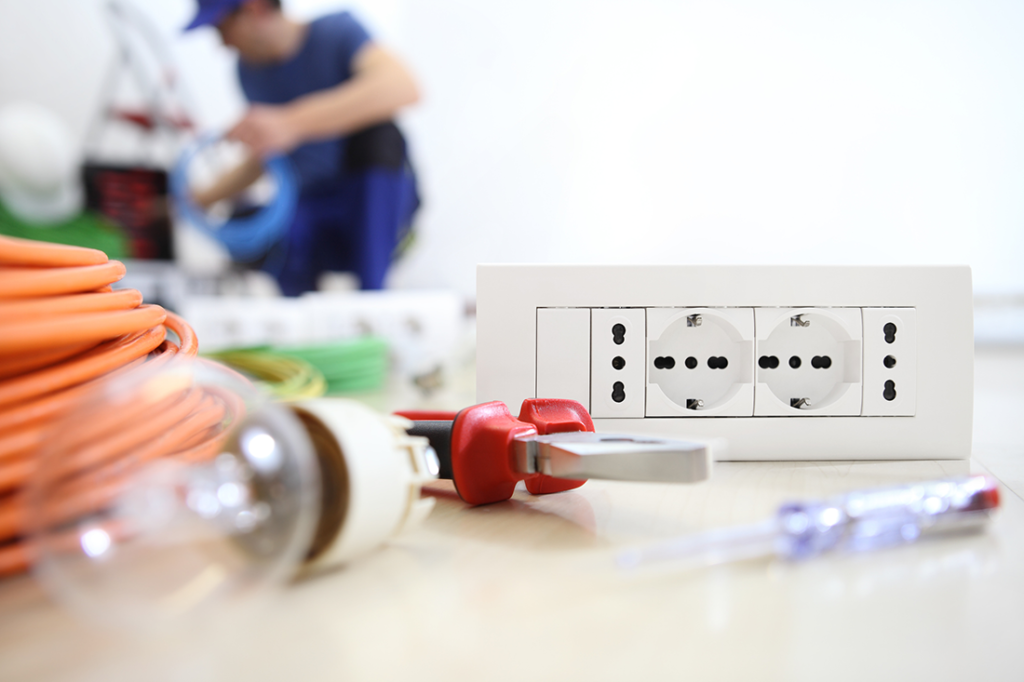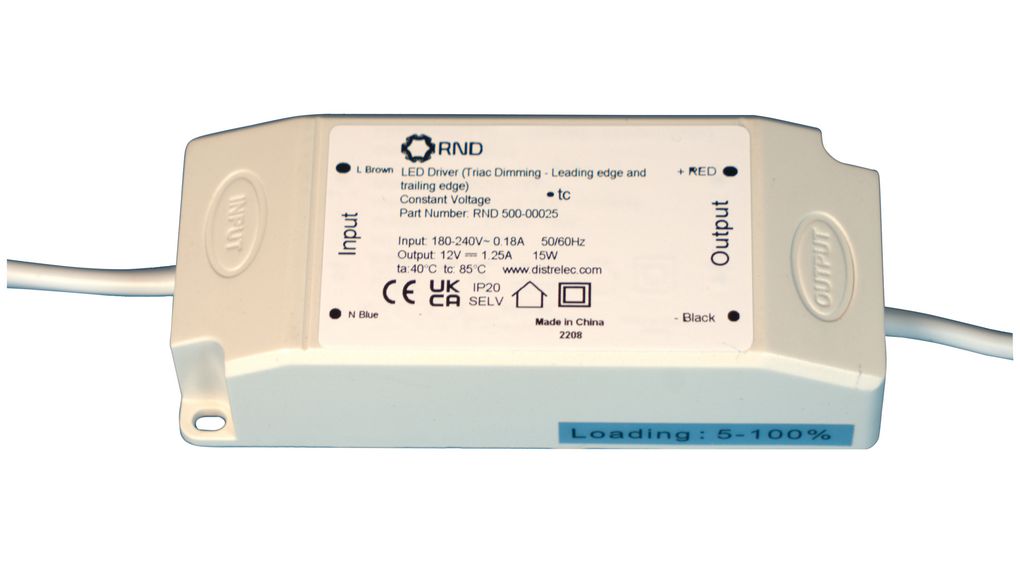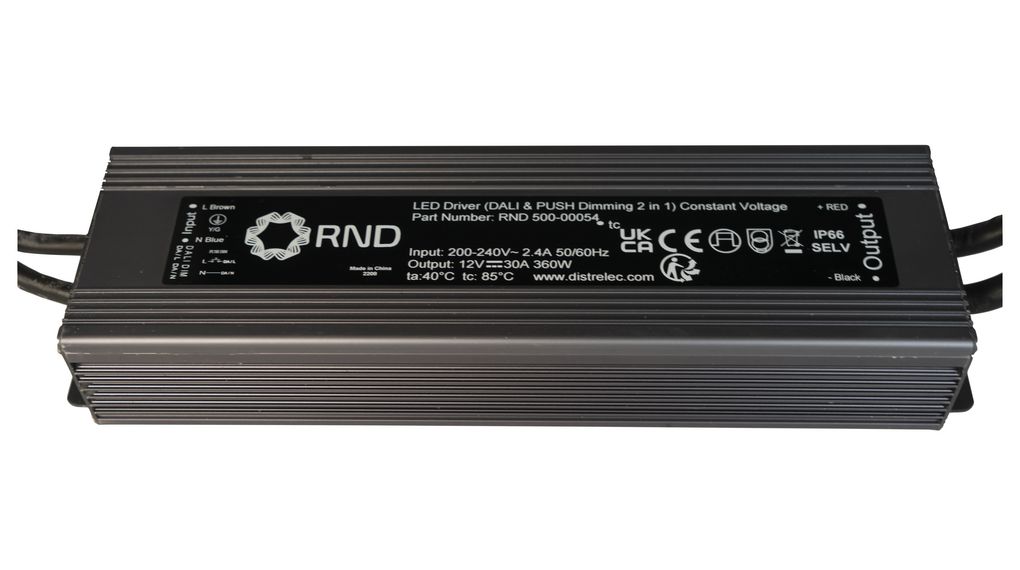With so many different types and varieties of LED drivers it can be a little confusing which one to choose. Fortunately, RND is there to light the way. The brand offers a new range of over fifty new LED drivers available in both 12V and 24V. Read on to find out more about LED technology and how to choose the right driver for your installation.
The development of LED technology
Even though the history of LED lighting is older, the full potential of light-emitting diodes (LEDs) wasn’t truly realised until discovered in the 60s by researchers and engineers, such as Nick Holonyak, Jr. (the “Father of the Light-Emitting Diode”).

Holonyak started focusing on creating more efficient LEDs. He designed the first light-emitting diode that generated visible red light instead of infrared light. Now the concept is used commonly in many devices; some popular application examples are:
- Traffic lights
- Camera flashes
- Lasers
- Planes and parking lots
- Device displays, such as TVs, PCs, tablets and cell and smartphones
- Railroad crossing and airport taxiway lights
- Consumer electronics
- Buttons and exit signs
- Microscopic surgical equipment
- Modular and task lighting
LED Drivers in brief
The advantages of light-emitting diodes over traditional incandescent light sources is that they offer very low energy consumption, long lifespan and are much more environmentally friendly. For them to function properly, LED lights need drivers (also called LED power supplies or light drivers) to convert high-voltage alternating current to low-voltage direct current. Therefore, a diode light driver is a self-contained power source that manages the power used by a light-emitting diode or its array.
LED drivers are an important piece of electrical equipment that controls the power to one or more light diodes. Another critical role of the driver is to protect LEDs from damage, and its inappropriate use might cause failure and possible damage to the components. Electrical current variations can cause a light bulb’s light output (brightness) to change or the bulb to overheat. Therefore, the light driver safeguards such a bulb from any current fluctuations if the voltage (power) changes.
Constant current and constant voltage
In the market, there are two different types of LED drivers: constant voltage drivers and constant current drivers, each serving a different function and application. Constant current drivers are designed for LEDs that require a fixed current but can withstand a range of different voltages. A constant current driver is best suited for powering LED downlights or high powered emitting diodes. In contrast a constant voltage driver is designed for lights that need a fixed voltage (of either 12 or 24v) with a current that’s being regulated by another safety device. Constant voltage drivers are best suited for brightly coloured lighting that needs a constant voltage to maintain its colour and intensity.

Voltage
The majority of LED equipment is low voltage. All LED strip lights require either 12V or 24V electricity, as specified in their specifications. Make sure to purchase a driver with the same output voltage as the LED light it’s powering. Using a 12V light with a 24V driver will increase the LED’s brightness in the short term, but the greater voltage will eventually burn out the tape.
Wattage
The wattage of a driver indicates its maximum output capability. It is recommended to select a driver that’s capable of a wattage that’s at least 10% higher than the wattage of the LED light it’s powering, as this ensures a longer lifespan of the system. The wattage of the LED itself is the amount of power it consumes during normal use. Too much power and they will burn out, too little power and they won’t function at all. As a result, it’s best to avoid connecting drivers to light-emitting diodes that use more than 80% of the driver’s maximum output.
Different types of LED drivers
Besides the constant current and constant voltage separation, light drivers can be grouped into categories based on employment within the LED bulb assembly, and they are either:
- Internal – internal drivers are normally found within domestic LED bulbs. These bulbs are especially made for home usage and use built-in drivers rather than separate, external ones.
- External – external drivers are normally used within commercial lighting applications, warehouse lighting and street lighting. Drivers are installed externally from the light as it is usually much cheaper to replace the external driver than to replace the entire light fixture.
There are also types of light drivers that vary depending on size, such as small or micro with a common rating of 4 watts or high power drivers.
The latest and most advanced LED technology are Chip-on-Board (COB) LEDs that consist of integrated electronics and several LEDs arranged in a cluster. They are really powerful, use less energy, and produce a high-quality beam of light.
The last category mentioned within this article is dimmable LED drivers, and RND has plenty of them in their product portfolio. Have a look below and find out more about dimmable drivers.
Dimmable LED drivers
Dimmable drivers provide the ability to reduce the power to the LED. Thanks to drivers with dimming capability, you can quickly change the brightness of the light. There are two main types of dimmable driver, these are trailing-edge dimmable drivers (sometimes referred to as electronic low voltage or ELV drivers) and leading-edge dimmable drivers (also known as triode for AC or TRIAC drivers).
Leading-edge drivers are usually the cheapest option, but they require a high-voltage light, making them less well suited to low voltage lighting application. The second type are trailing-edge dimmable drivers, these are more complex than leading-edge dimmable drivers and provide a smoother level of control.
There are also DALI LED drivers, DALI (Digital Addressable Lighting Interface) is an international standard for communication within LED Lighting and provides a two-way communication system that allows for much more functionality and control over analogue control devices.
RND provides a comprehensive range of both TRIAC and DALI LED drivers.


What LED driver do you need?
Before deciding which light driver will be the best for your application or project, you need to consider a few things:
- Compatibility
First of all, make sure your LED driver is fully compatible with your power supply and the system you intend to attach it to. It means that the parameters of the led driver should match those of the LED, such as voltage, current, etc.
- Conditions
Define the external environment where the driver is located. For example, if you are installing LEDs in an outdoor environment, make sure that your driver has a sufficient level of water resistance. There are LED drivers made specifically for outdoor settings.
- Wires
Identify the (P) positive and (N) negative wires in your socket, then disconnect the socket from the grid. Remember that if drivers and transformers lack terminals, then users need to attach a plug straight onto the cable’s end. Bear in mind that only skilled and qualified professionals should do the wiring.
- Installation

The next process requires installing the driver and attaching it to the LED system with suitable, colour-coded screws. Connect the positive and negative wires from the light system to the corresponding terminals on the driver. Then, connect the green grounding wire (the GND) on the driver to a grounding terminal. Finally, connect the positive and negative wires in the power socket to the corresponding terminals on the driver.
- Testing
You can now test the installation thoroughly to make sure all connections are secure and applied correctly, check that the heat is being dissipated properly, and all the cables are linked securely. In the case of a failure, turn off the power first and carefully inspect the connection to see whether there is a problem. It is necessary to replace the LED driver if it is broken.
You can test an LED driver in these three ways:
- Connecting it to the LED system and observing the result.
- Using electronic testing equipment, for example, a voltmeter that allows testing light driver’s output voltage. Be careful since constant current LED drivers may be operating at an extremely high voltage.
- Applying a load resistor.
Light your way with RND LED Drivers
Now that you know which light driver you need, you might choose the ones from RND. In this brand’s offer are fifty-one LED drivers that are easily available in both 12V and 24V and have a wide variety of power outputs, from 15W to 300W. RND LED drivers will ensure that you have enough power for all of your lighting options. Click the button below to explore the new RND drivers range.
FAQs
LED drivers are specialised power conversion devices that work with LED lighting. Such drivers provide LEDs with a stable power supply by converting alternating current (AC) to direct current (DC). They deliver consistent and uninterrupted power supply by correcting changes in temperature and electrical conductivity. This prevents the LEDs from overheating, flickering, changing colour and degrading in performance.
LED drivers are devices that control and deliver the electricity required to ‘drive’ LED lighting. Drivers act similarly to transformers for low-voltage lights. LED lights are generally low-voltage devices requiring a direct current power source (usually 4v, 12v, or 24v). Most wall socket power sources, on the other hand, are not directly compatible since they operate at a significantly higher voltage (between 120 and 277V) and produce alternating currents. Because an LED’s average voltage is too low for a standard transformer, specialised light drivers are used to convert high voltage alternating current to low-voltage direct current.
LED drivers safeguard LED lights from current and voltage changes. The drivers have power output levels that correspond to LED needs. They guarantee that the voltage and current to the LED bulbs remain within the LEDs’ operational range despite variations in the power supply.
Yes, a driver is necessary for every LED light source. However, some LEDs, particularly those made for home use have inbuilt drivers instead of external drivers.
As mentioned above, some LED bulbs might already contain an integrated driver. However, lower-voltage LEDs generally require a separate driver. Although it is not a big issue as if the driver fails, it may be replaced without replacing the bulb.
The environmental temperature and humidity must be considered while installing the LED driver. The lead driver requires a position that is mostly dry and well-ventilated in order to operate steadily and in the best conditions possible.
There are some LED drivers with dimmable capabilities, grouped in two types: trailing-edge dimmable drivers and leading-edge dimmable drivers, both function by lowering the amount of power provided to the LED. If you want to buy dimmable drivers, ensure that it states on the package that they are dimmable.
There are two categories: AC-DC and DC-DC LED drivers. While the DC power source for DC-DC LED drivers might come from an AC to DC power supply or a DC input like a centralised power supply bus or a battery, the AC power source for AC-DC LED drivers is directly linked to the mains. It is important to carefully review the datasheet; if the LED bulb needs a DC voltage input, an AC LED driver cannot be used.
There are plenty of electronic shops where you can find and purchase LED lighting systems, bulbs and drivers. We recommend browsing the Distrelec webshop and checking out our selection of RND LED drivers. They are easily accessible and are perfect for a wide range of lighting applications.











